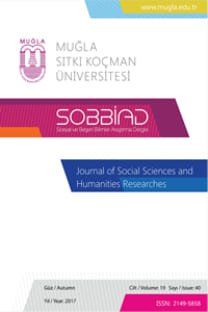Yabancı Dil Sınıflarında Deyim Öğretiminde Kavramsal Mecazların Kullanımı
Bu çalışma, yabancı dil sınıflarında İngilizce deyimleri öğretmede kavramsal mecaz kullanmanın ne derece etkili olabileceğini araştırmayı hedeflemektedir. Araştırmanın örneklemini Sözcük Bilgisi dersini alan İngiliz Dili Eğitimi birinci sınıf öğrencileri oluşturmaktadır. Araştırma amacına yönelik daha önceden belirlenen deyimler öğretmek ders planları geliştirilmiş ve bu planlar iki hafta boyunca sınıfta uygulanmıştır. Veri toplama aracı olarak 28 soruluk bir başarı testi ve açık uçlu sorulardan oluşan bir anket formu kullanılmıştır. Hem testlerden hem açık uçlu sorulardan oluşan anketten elde edilen bulgular, kavramsal mecazlar yoluyla İngilizce deyimleri öğretmenin öğrenme ve kalıcılık üzerinde etkili olduğunu göstermektedir.
Anahtar Kelimeler:
Deyim Öğretimi, Kavramsal Mecazlar, Yabancı Dil Öğretimi
Using Conceptual Metaphors in Teaching Idioms in a Foreign language Context
This study aims at exploring the effects of using conceptual metaphors in teaching idioms in a foreign language context. The participants are the first year students of English Language Teaching (ELT) Department of Faculty of Education who take the course “Lexical Competence”. Lesson plans were developed for this purpose. These lesson plans contain activities that aim to teach idiomatic expressions, their meanings and the logic behind them in order to enhance learners’ metaphoric perceptions in the target language. They were implemented in 10 hour-periods (devoted two hours to each lesson plan). The effect of this implementation on language learners’ metaphor awareness and success in understanding the meaning of idioms is evaluated by the use of pre-and post-tests and an open-ended questionnaire. The results obtained show that this implementation enhanced language learners’ metaphor awareness and success in understanding idiomatic expressions, and it can be suggested as an additional channel for learning idioms in a FL vocabulary class.
___
- Black, M, (1979). More about metaphor. In A. Ortony (Ed.). Metaphor and thought. New York: Cambridge University Press. Boers, F. (2000). Metaphor awareness and vocabulary retention. Applied Linguistics, 21(4), 553-571.
- Boers, F. (2003). Applied linguistics perspectives on cross-cultural variation in conceptual metaphor. Metaphor and Symbol, 18(4), 231-238.
- Boers, F., Demecheleer, M., & Eyckmans, J. (2004). Cross-cultural variation as a variable in Comprehending and remembering figurative idioms. European Journal of English Studies, 8(3), 375-388.
- Cameron, L., & Deignan, A. (2006). The emergence of metaphor in discourse (Electronic version). Applied Linguistics, 27(4), 671–690.
- Carter, R. & McCarthy, M. (1988). Vocabulary and language teaching. London: Longman.
- Charteris-Black, J. (2002). Second language figurative proficiency: A comparative study of Malay and English. Applied Linguistics, 23(1), 104–133.
- Cooper, C. T. (1998). Teaching idioms. Foreign Language Annals, 31(2), 255- 266. Cornell, A. (1999). Idioms: an approach to identifying major pitfalls for learners. IRAL, 37(1), 1-21.
- Deignan, A., Gabryś, D., & Solska, A. (1997). Teaching English metaphors using cross- linguistic awareness-raising activities (Electronic version). ELT Journal, 51(4), 352- 360.
- Ellis, R., & Barkhuizen, G. (2005). Analyzing learner language. Oxford: University Press. Fernando, C. (1996). Idioms and idiomaticity. Oxford: Oxford University Press.
- Gairns, R. & Redman, S. (1986). Working with words. Cambridge: Cambridge University Press.
- Gibbs, R. W. (1994). The poetics of Mind. Cambridge, England: Cambridge University Press. Giora, R. (2003). On our mind: salience, context and figurative language. New York: Oxford University Press.
- Guerrero de M. C. M., & Villamil, O. S. (2002). Metaphorical conceptualizations of ESL teaching and learning. Language Teaching Research, 6(2), 95-120.
- Kittay, E. (1987). Metaphor: Its cognitive force and linguistic structure. Oxford: Oxford University Press.
- Kövecses, Z. (2003). Language, figurative thought, and cross-cultural comparison. Metaphor and Symbol, 18 (4), 311-320.
- Kövecses, Z., & Szabó, P. (1996). Idioms: A view from cognitive semantics. Applied Linguistics, 17(3), 326-335.
- Lakoff, G. (1987). Women, fire and dangerous things: what categories reveal about the mind. Chicago/London: University of Chicago Press.
- Lackoff, G., & Johnson, M. (1980). Metaphors we live by. Chicago/London: The University of Chicago Press.
- Lattey, E. (1986). Pragmatic classifications of idioms as an aid for the language learner. IRAL, 34(3), 217-33.
- Lazar, G. (1996). Using figurative language to expand students‟ vocabulary. ELT Journal, 50(1), 43-51.
- Lennon, P. (1998). Approaches to the teaching of idiomatic language. IRAL, 36 (1), 12–30.
- Littlemore, J., & Low, G. (2006). Metaphoric competence, second Language learning, and communicative language ability. (Electronic version). Applied Linguistics, 27(2), 268-294.
- Littlemore, J. (2001). Metaphoric intelligence and foreign Language learning. HLT Magazine, 3(2), http://www.hltmag.co.uk/mar01/mart1.htm
- Liu, D. (2003). The most frequently used spoken American English idioms: a corpus analysis and its implications. TESOL Quarterly, 37(4), 671-700.
- Moon, R. (1998). Fixed expressions and idioms in English. Oxford: Clarendon Press.
- Ponterotto, D. (1994). Metaphors we can live by (Electronic version). Forum, 32(3), retrieved from http://exchanges.state.gov/forum/vol5/vol132/no3/p2.htm.
- Schmitt, N. (2000). Vocabulary in language teaching. Cambridge: Cambridge University Press.
- Simpson, R., & Mendis, D. (2003). A corpus-based study of idioms in academic Speech. TESOL Quarterly, 37(3), 419-441.
- Wray, A. (1999). Formulaic language in learners and native speakers. Language Teaching, 32, 213-231.
- Wray, A. (2000). Formulaic sequences in second language teaching: Principles and practice. Applied Linguistics, 21(49. 463-489.
- ISSN: 2149-5858
- Yayın Aralığı: Yılda 2 Sayı
- Başlangıç: 2000
- Yayıncı: Mugla Sitki Kocman University
Sayıdaki Diğer Makaleler
MYLASA ANTİK KENTİNDEN BOYA BEZEMELİ BİR İON BAŞLIĞI
Anadolu’da Bir İlhanlı Valisi: Demirtaş Noyan (1314-1328
YUNAN TARiHÇİLERİNİN GÖZÜYLE 1930 TÜRK-YUNAN DOSTLUK ANTLAŞMASI VE VENİZELOS’UN BU SÜRECE KATKILARI
İNGİLİZCE ÖĞRETMEN ADAYLARININ GÜDÜLEME STRATEJİLERİNİ DEĞERLENDİRMELERİ
İzzet GÖRGEN, Şevki KÖMÜR, Sabahattin DENİZ
ESARETTEN KURTULUŞ: İTİLÂF DEVLETLERİNİN İSTANBUL’U TAHLİYESİ
KÜRESELLEŞME, NEO-LİBERALİZM VE REFAH DEVLETİ İLİŞKİSİ ÜZERİNE
Yabancı Dil Sınıflarında Deyim Öğretiminde Kavramsal Mecazların Kullanımı
Şevki KÖMÜR, Şeyda SELEN ÇİMEN
ÇOCUK EDEBİYATI KİTAPLARINDA ŞİİRİN YERİ
KAMU TERCİHİ VE ANAYASAL İKTİSAT KURAMI ÜZERİNE BİR DEĞERLENDİRME
